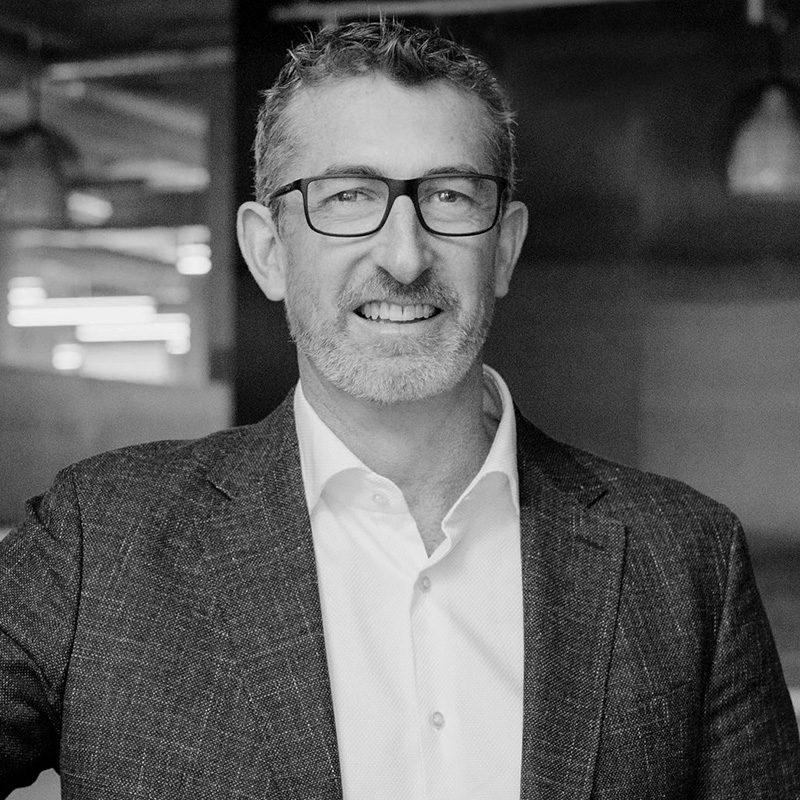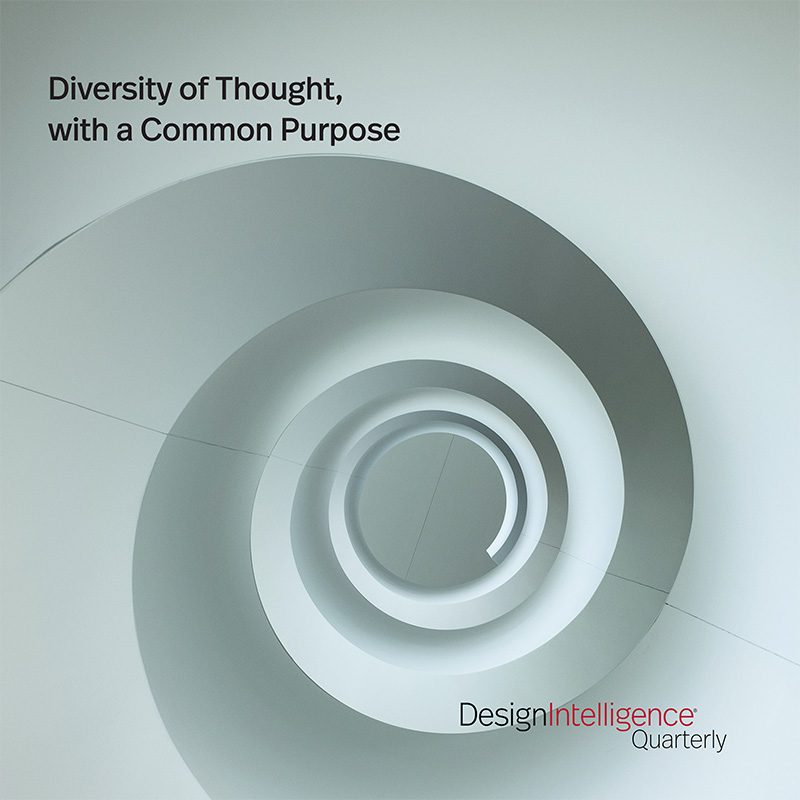Diversity of Thought, with a Common Purpose
by Jim Anderson
Principal and
Chair of DIALOG
September 8, 2021
DIALOG is a design practice that is rooted in and works across Canada. While large geographically, Canada is actually fairly small by any other measure—yet Canadians are diverse and have a wide-ranging perspective. Even though our regions are sparsely populated, we have our regional differences.
When we talk about our approach to design and design practice, we have described our A/E firm as “an architecture, engineering, urban design, planning, landscape architecture and interior design firm.”
But recently, as we were working through a strategic planning process, it became much more important to us to describe the firm simply as a “design practice.” This is a much more all-encompassing descriptor of how we and the industry go about solving the problems of today. Today’s problems need solutions from a number of different perspectives—not just from an architectural, structural, mechanical, electrical perspective. Design has many more constituent parts today than it’s had in the past. Our practice and our teams are being formulated that way. At DIALOG, we stopped trying to list the number of disciplines we have in our practice because we are now hiring a more diverse range of subject matter experts such as anthropologists, data experts, healthcare practitioners and more. We will only see more of this in the industry—this bringing together of nontraditional experts that we may not have thought were a part of the design world before. This is what is required to solve the design problems of today and of the future. In this way, we are broadening the foundation from which design is created.
A useful comparative illustration to describe this perspective is the idea of a mosaic vs. melting pot.
The mosaic perspective is where each constituent part of the practice maintains its own identity, strong in its own particular perspective or area of knowledge, but each contributes in its own unique way that creates a much different, meaningful, rich and larger picture. To fold that example into design—this creates a more meaningful and rich solution to a problem. Canada prides itself on having an historical approach to immigration and multiculturalism that is rooted in this mosaic vs. melting pot analogy. The cultural mosaic is based on a belief that Canada as a whole becomes stronger by having immigrants bring with them their cultural diversity for all Canadians to learn from. This is in stark contrast to a melting pot approach whereby assimilation and cultural homogeneity is sought.
The mosaic perspective shapes our practice, embracing both diversity and collaboration as key parts of the practice—these two must go hand in hand. Having collaboration with a bunch of like-minded thinkers only gives us one thing—capacity. But having collaboration with a very diverse range of thought gives a much more meaningful solution.
Conversely, it is pointless to have a diversity of perspective while the people work in their own corner by themselves. We’re not leveraging the power of either collaboration or diversity unless we have a diverse group of thinkers that actually collaborate. These are two key ingredients to having a multidisciplinary design practice. The constituent parts are important, but the way they work together is what creates the magic.
This is where the profession is going, I believe.
But this brings up an interesting question, and that is, how does all of this work practically? This is one of the struggles
of a firm that is intentionally bringing together professionals from diverse backgrounds with broad experience. When we initially started working toward this type of practice, we wondered if we were actually building a powder keg because we were bringing together people with ideas that can be so at odds with others, at times.
Years ago, I read a book titled The Starfish and the Spider [written by Ori Brafman and Rod Beckstrom] that talked about the power of decentralized organizations. The premise of the book is that a starfish has a decentralized nervous system—if one of its legs is cut off, the starfish can regenerate another leg. Not so with a spider. The starfish represents the decentralized model, which is an interesting model to study in business. But generally, most businesses are a hybrid of centralized and decentralized. I would say that DIALOG is far more decentralized than centralized.
To make it work practically, everyone must understand the common goal, the common purpose. For DIALOG, it drives home the notion that we are
a purpose-driven organization—and that purpose is meaningfully improving communities. As an organization, we’re aligned
around that purpose. It is the glue that holds us together. It is the reason we design. With that alignment around our purpose, we can
arrive at
a solution from completely different perspectives.
Recently, we had a summer student who designed an app for us. I asked him what was the most important thing he learned at DIALOG over the summer. His response? “The most important thing I learned this summer was that in order to help someone solve a problem, first you must understand their perspective on the problem and how it might be radically different from your perspective on the problem.
“If I just provide somebody with my solution without understanding their perspective,” he said, “then I’m just driving toward my solution. And you don’t end up with a good solution that way. I didn’t go to work for a structural engineering firm; I went to work for a multidisciplinary firm. I had fun working with a whole bunch of designers who saw the same problem in a very different way than me,” he said.
But again, it’s about having that common purpose in front of you that you’re focused on. That’s the key to making a multidisciplinary, radically diverse type of decentralized organization work.
When we landed on our purpose to meaningfully improve the wellbeing of communities, we realized that was an easy thing to say, but how would we know when we were actually improving communities? This is a hugely complex task to undertake. With a multidisciplinary team gathered around that common purpose of improving communities, there has to be a determination of what we’re going to try to effect or impact. This was the whole impetus for creating the Community Wellbeing Framework—which was a deep research project we undertook with the Conference Board of Canada.* The framework helps us as a practice answer the question of determining whether we’re improving communities and the effectiveness of our solutions.
As our summer student said, the design mandate around this common purpose is to truly listen to the client to understand the client’s problem. And many times, that may mean listening in a very deep way because the client may articulate a problem that’s quite different from what they originally thought was the issue. By listening and understanding the client, we can deliver a solution that solves their problem.
Over the next few years, as we work ever more toward this idea of the mosaic, our firm will continue to evolve and look more and more multifaceted. All of this diversity of thought and approach doesn’t have to necessarily happen under one roof. But it is a way of working that will also evolve to look much more interactive and engaging as opposed to even the way we may have approached a project even ten years ago.
I’m frequently asked if our business model will have to change to adapt to this new approach and way of solving problems.
I would say that the model has changed but very slowly. The overarching business model of providing consulting services and getting paid for services probably won’t change. But how we get paid based on the value we bring as opposed to our time spent has already changed—and it will continue to change where we’re much more of a value-based service as opposed to a time-based service.
For the Canadian market, there’s increasingly a focus on and an understanding that for the sake of long-term investment, we as an industry have to be thinking about the wellbeing of stakeholders. For example, our federal government has recently mandated that all new government buildings have a zero-carbon target. They are clearly mandating more than just environmental sustainability—they are looking at the health and wellness of building users as being at the forefront of any design solution. But we’re also seeing this approach with developers—in that we are understanding the value of the public realm that creating a better space for people is a commercial- and business-oriented move. Same old, same old just doesn’t work any longer in our rapidly changing environment, whether it’s a developer, an institution or a government.
The globalization of our profession is here to stay. One of the challenges in our profession and with our clients is that everybody every day is comparing precedents or ideas to what is happening around the world. We no longer have to wait for a project to be published anymore. Everyone is always looking globally for benchmarks and precedents, including clients and clients’ clients, investors and users. So, I believe that the borders of nations don’t exist in the design profession any longer, other than the regulatory environment—and those boundaries will exist in the regulatory environment for the foreseeable future.
It is incredibly encouraging when we take seriously our role in the built environment. If we believe that great design can change the world, and we want what we design and build to have a positive influence, why would we build or design something that would have a negative impact? The absurdity of what we’ve done to the planet for generations is mind boggling, especially since we have the capacity to do the opposite. This isn’t a criticism of what I and others have done in the past. Rather, I believe it was a lack of awareness. But now that we’re aware that we can have a positive impact on the wellbeing of people, communities, and the environment, let’s put all of our energy into making everything we do positive.
* For more information about the Community Wellbeing Framework (published by the Conference Board of
Canada in collaboration with DIALOG), visit the DIALOG
website.
Jim Anderson is an architect, principal and current Chair of DIALOG. He believes deeply in building a purpose-driven firm; one that’s founded on our collaborative and multidisciplinary approach to building stronger communities throughout Canada and the U.S.


